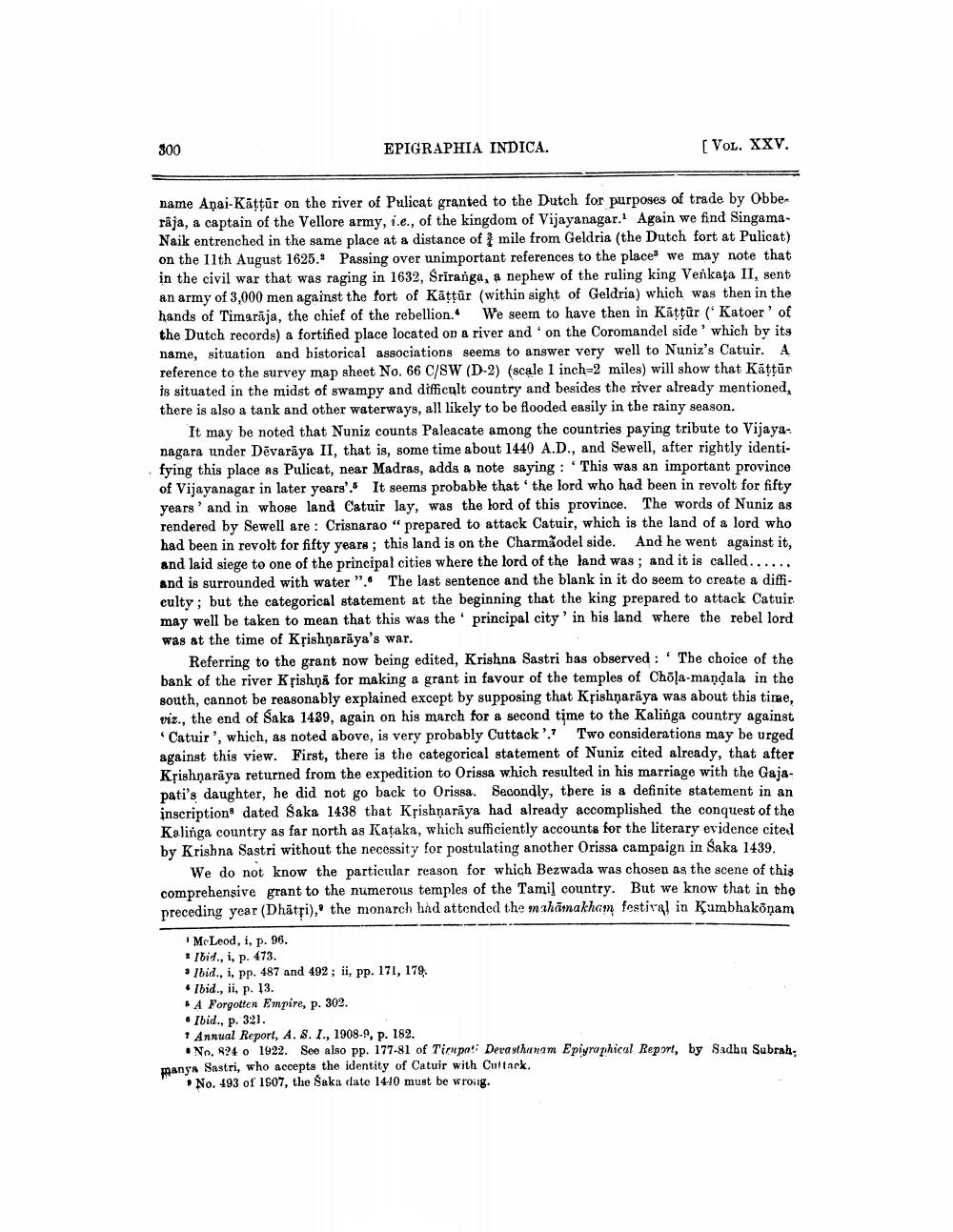________________
300
EPIGRAPHIA INDICA.
[VOL. XXV.
name Anai-Kāțţūr on the river of Pulicat granted to the Dutch for purposes of trade by Obber rája, a captain of the Vellore army, i.e., of the kingdom of Vijayanagar.! Again we find SingamaNaik entrenched in the same place at a distance of mile from Geldria (the Dutch fort at Pulicat) on the 11th August 1625. Passing over unimportant references to the places we may note that in the civil war that was raging in 1632, Sriranga, a nephew of the ruling king Venkata II, sent an army of 3,000 men against the fort of Kāttür (within sight of Geldria) which was then in the hands of Timarāja, the chief of the rebellion. We seem to have then in Kāțţūr Katoer' of the Dutch records) a fortified place located on a river and on the Coromandel side' which by its name, situation and historical associations seems to answer very well to Nuniz's Catuir. A reference to the survey map sheet No. 66 C/SW (D-2) (scale 1 inch=2 miles) will show that Kātřūr is situated in the midst of swampy and difficult country and besides the river already mentioned, there is also a tank and other waterways, all likely to be flooded easily in the rainy season.
It may be noted that Nuniz counts Paleacate among the countries paying tribute to Vijayanagara under Dēvarāya II, that is, some time about 1440 A.D., and Sewell, after rightly identifying this place as Pulicat, near Madras, adds a note saying: This was an important province of Vijayanagar in later years'. It seems probable that the lord who had been in revolt for fifty years' and in whose land Catuir lay, was the lord of this province. The words of Nuniz as rendered by Sewell are: Crisnarao "prepared to attack Catuir, which is the land of a lord who had been in revolt for fifty years; this land is on the Charmãodel side. And he went against it, and laid siege to one of the principal cities where the lord of the land was; and it is called...... and is surrounded with water ”.. The last sentence and the blank in it do seem to create a diffieulty; but the categorical statement at the beginning that the king prepared to attack Catuir. may well be taken to mean that this was the principal city ' in bis land where the rebel lord was at the time of Krishnarāya's war.
Referring to the grant now being edited, Krishna Sastri bas observed : ' The choice of the bank of the river Krishna for making a grant in favour of the temples of Chöļa-mandala in the south, cannot be reasonably explained except by supposing that Krishnarāya was about this time, viz., the end of Saka 1439, again on his march for a second time to the Kalinga country against
Catuir', which, as noted above, is very probably Cuttack '.' Two considerations may be urged against this view. First, there is the categorical statement of Nuniz cited already, that after Krishnaraya returned from the expedition to Orissa which resulted in his marriage with the Gajapati's daughter, he did not go back to Orissa. Secondly, there is a definite statement in an inscription dated Saka 1438 that Krishnarāya had already accomplished the conquest of the Kalinga country as far north as Kataka, which sufficiently accounts for the literary evidence cited by Krishna Sastri without the necessity for postulating another Orissa campaign in Saka 1439.
We do not know the particular reason for which Bezwada was chosen as the scene of this comprehensive grant to the numerous temples of the Tamil country. But we know that in the preceding year (Dhātri), the monarch had attended the mahāmakham festival in Kumbhakõnam
McLeod, i, p. 96.
Ibid., i, p. 473. • Ibid., i, pp. 487 and 492 ; ii, pp. 171, 179. • Ibid., ii, p. 13. - A Forgotten Empire, p. 302. • Ibid., p. 321. 1 Annual Report, A. S. 1., 1908-9, p. 182.
.No. 494 o 1922. See also pp. 177-81 of Tirupat: Devasthanam Epigraphical Report, by Sadhu Subrah. manya Sastri, who accepts the identity of Catuir with Cultnek,
.No. 493 of 1907, the Saka dato 1410 must be wroig.




